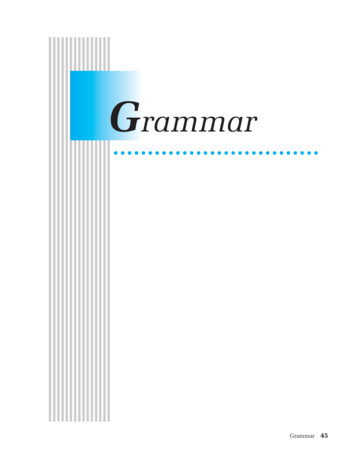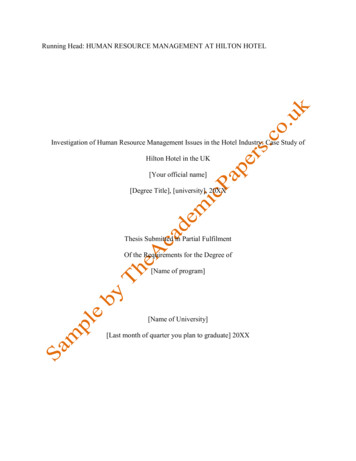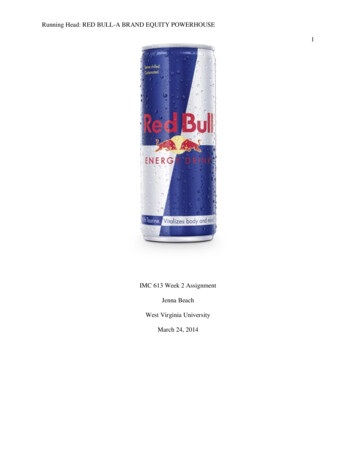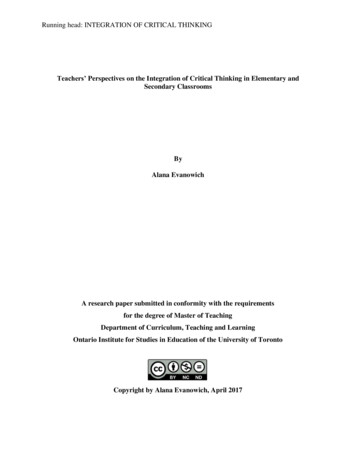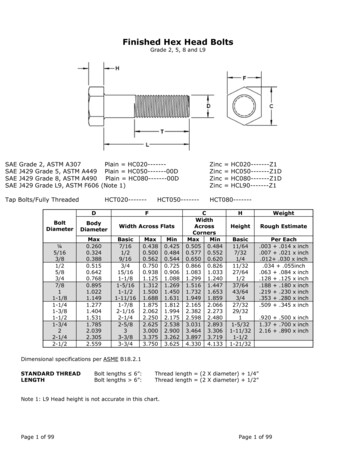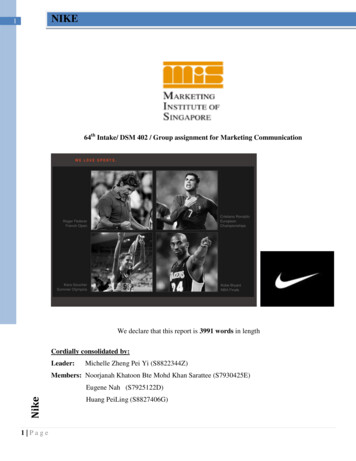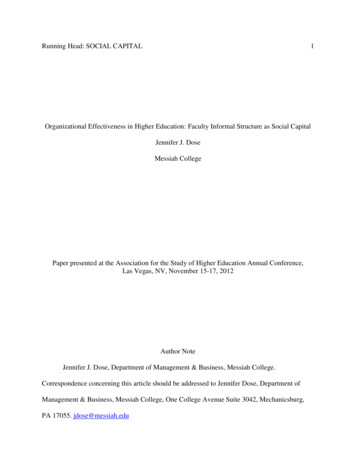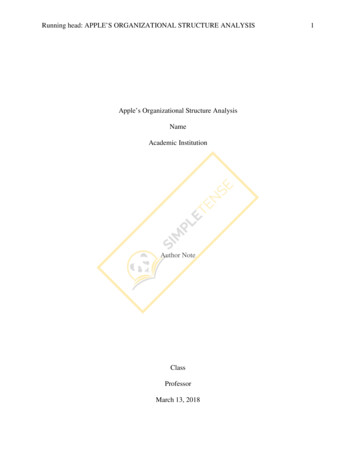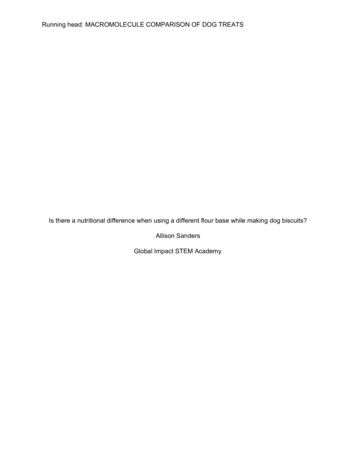
Transcription
Danish inHead-DrivenPhrase StructureGrammarTFARDStefan Müller and Bjarne Ørsnes r ,ofbetocO , :
Preface e aim of this book is twofold: First we want to provide a precise description of a largefragment of the Danish language that is useful for readers regardless of the linguisticframework they work in. is fragment comprises not only core phenomena such asconstituent order and passivizating, but to a large extent also a number of less-studiedphenomena which we believe to be of interest, not only for the description of Danish(and other mainland Scandinavian languages), but also for comparative work in general.It has been an important goal for us to base our analyses on comprehensive, empiricallysound descriptions of the studied phenomena. For that reason we mainly use real dataextracted from a corpus or from web-pages. e second aim of the book is to provide afully formalized linguistic theory of the described fragment that is provably internallyconsistent and furthermore compatible with psycholinguistic theories and with insightsabout human language from language acquisition research. e linguistic theory will beworked out in the framework of Head-Driven Phrase Structure Grammar (Pollard & Sag , ), but readers who do not care about formal linguistics or this particular branchof formal linguistics do not have to worry: the book is organized in a way that makesit possible to read the descriptive parts of the respective chapters without reading theanalysis parts. However, we think that dealing with the analyses will result in a be erunderstanding of the language facts, so it may be worthwile to read the analysis sectionseven for those who are new to HPSG.In what follows we describe the project and the guiding linguistic assumptions inmore detail and then make some brief remarks about Danish and the data we have used.
e Project is book is part of a larger project, called CoreGram, with the goal to develop large scalecomputer processable grammar fragments of several languages that share a commoncore (Müller a,b). Currently we work on the following languages: German (Müller b, b; Müller & Ørsnes ) Danish (Ørsnes b; Müller b; Müller & Ørsnes , In Preparation) Persian (Müller b; Müller & Ghayoomi ; Müller, Samvelian & Bonami InPreparation) Maltese (Müller a) Mandarin Chinese (Lipenkova ; Müller & Lipenkova , ) Yiddish (Müller & Ørsnes ) English Spanish FrenchFor the implementation we use the TRALE system (Meurers, Penn & Richter ; Penn ), which allows for a rather direct encoding of HPSG analyses (Melnik ). egrammars of German, Danish, Persian, Maltese, and Mandarin Chinese are of non-trivialsize and can be downloaded at http://hpsg.fu-berlin.de/Projects/CoreGram.html. eyare also part of the version of the Grammix CD-rom (Müller a) that is distributedwith this book. e grammars of Yiddish and English are toy grammars that are usedto verify cross-linguistic analyses of special phenomena and the work on Spanish andFrench is part of work in the Sonderforschungsbereich which just started. See Bildhauer ( ) for an implemented grammar of Spanish that will be converted into theformat of the grammars mentioned above.We believe that books are the best way to document such fragments since it is o ennot possible to construct a coherent view of one language from journal articles. ereason is that journal articles tend to need a long time from first submission to finalpublication and sometimes basic assumptions may have changed during the development of the linguistic theory in the meantime. e first book in this series was Müller( b), which describes a fragment of German that is implemented in the grammarBerliGram. Another book on the Persian Grammar developed in the PerGram project isin preparation (Müller, Samvelian & Bonami In Preparation). e situation in mainstream formal linguistics has o en been criticized: basic assumptions are changed in high frequency, sometimes without sufficient motivation. Someconcepts are not worked out in detail and formal underpinnings are unclear (see for instance Gazdar, Klein, Pullum & Sag : p. ; Pullum , , : p. ; Kornai &ivDra of October , , :
Pullum ; Kuhns ( : p. ); Crocker & Lewin ( : p. ); Kolb & iersch ( :p. ); Kolb ( : p. – ); Freidin ( : p. ); Veenstra ( : p. , ); Lappin et al.( : p. ); Stabler ( : p. , , ); Fanselow ( )). For a more detaileddiscussion of this point see Müller ( a: Chapter . ). As already mentioned, we workin the framework of HPSG, which is well-formalized (King ; Pollard ; Richter ) and stable enough to develop larger fragments over a longer period of time. HPSGis a constraint-based theory which does not make any claims on the order of applicationof combinatorial processes. eories in this framework are just statements about relations between linguistic objects or between properties of linguistic objects and hencecompatible with psycholinguistic findings and processing models (Sag & Wasow ).As is argued in Müller ( a: Chapter . ), HPSG is compatible with UG-based models of language acquisition as for instance the one by Fodor ( ). See Fodor ( :p. ) for an explicit remark to that end. However, in recent years evidence has accumulated that arguments for innate language specific knowledge are very weak. Forinstance, Johnson ( ) showed that Gold’s proof that natural langauges are not identifiable in the limit by positive data alone (Gold ) is irrelevant for discussions of humanlanguage acquisition. Furthermore, there is evidence that the input that humans haveis sufficiently rich to aquire structures which were thought by Chomsky ( : p. – ) and others to be inacquirable: Bod ( ) showed how syntactic structures could bederived from an unannotated corpus by Unsupervised Data-Oriented Parsing. He explained how Chomsky’s auxiliary inversion data can be captured even if the input doesnot contain the data that Chomsky claims to be necessary (see also Eisenberg ( ) andPullum & Scholz ( ); Scholz & Pullum ( ) for other Poverty of the Stimulus arguments). Input-based models of language acquisition in the spirit of Tomasello ( )seem highly promising and in fact can explain language acquisition data be er thanprevious UG-based models (Freudenthal et al. , ). We argued in Müller ( a)that the results from language acquistion reasearch in the Construction Grammar framework can be carried over to HPSG, even in its lexical variants. If language acquisition isinput-based and language-specific innate knowledge is minimal as assumed by Chomsky ( ); Hauser, Chomsky & Fitch ( ) or non-existing, this has important consequences for the construction of linguistic theories: Proposals that assume more than morpho-syntactic categories that are all innate and that play a role in all languages ofthe world even though they are not directly observable in many languages (Cinque &Rizzi ) have to be rejected right away. Furthermore, it cannot be argued for emptyfunctional projections in language X on the basis of overt morphems in language Y. is has been done for Topic Projections that are assumed for languages without topicmorphemes on the basis of the existence of a topic morpheme in Japanese. Similarly,functional projections for object agreement have been proposed for languages like English and German on the basis of Basque data even though neither English nor German In fact we believe that a lexical treatment of argument structure is the only one that is compatible withthe basic tenets of theories like Categorial Grammar (CG), Lexical Functional Grammar (LFG), CxG, andHPSG that adhere to lexical integrity (Bresnan & Mchombo ). For discussion see Müller ( ), Müller( a: Chapter . ), Müller ( b), Müller (To appear(c)), and Müller & Wechsler (To appear).Dra of October , , : v
has object agreement. Since German children do not have any evidence from Basque,they would not be able to acquire that there are projections for object agreement andhence this fact would have to be known in advance. Since there is no theory externalevidence for such projections, theories that can do without such projections and without stipulations about UG should be preferred. However, this does not mean that thesearch for universals or for similarities between languages and language classes is fundamentally misguided, although it may be possible that there is very li le that is truelyuniversal (Evans & Levinson ): In principle there exist infinitely many descriptionsof a particular language. We can write a grammar that is descriptively adaquate, butthe way the grammar is wri en does not extend to other languages. So even withoutmaking broad claims about all languages it is useful to look at several languages and themore they differ from each other the be er it is. What we try to do here in this bookand in the CoreGram project in general is the modest version of main stream generativegrammar: We start with grammars of individual languages and generalize from there.We think that the framework we are using is well-suited for capturing generalizationswithin a language and across languages, since inheritance hierachies are ideal tools forthis (see Section . ). Of course when building grammars we can rely on several decadesof research in theoretical linguistics and build on insights that were found by researchersworking under UG-oriented assumptions. Without a theory-driven comparative look atlanguage certain questions never would have been asked and it is good that we havesuch valuable resources at hand although we see some developments rather critical asshould be clear from the statements we made above.Returning to formalization of linguistic theories, the same criticism that applies toGB/Minimalism applies to Construction Grammar: e basic notions and key conceptsare hardly ever made explicit with the exception of Sign-Based Construction Grammar(Sag , ), which is an HPSG-variant, Embodied Construction Grammar (Bergen& Chang ), which uses feature value matrices and is translatable into HPSG (seeMüller ( a: Chapter . ) for the discussion of both theories), and Fluid Construction Grammar (Steels ). Müller ( a: Chapter . . ; To appear(c)) showed that thecombinatory operations of Minimalism as defined in Chomsky ( ) and Stabler ( )corresponds to three of the schemata used in HPSG grammars since at least Pollard& Sag ( ): Merge corresponds the Head-Specifier Schema and the Head-ComplementSchema of HPSG and Move corresponds to the Head-Filler Schema. So HPSG can be saidto provide an explicit formalization of Minimalist ideas. HPSG differs from Minimalismin important respects though: It is constraint-based rather than generative-enumerative. e implications of this cannot be discussed in full detail here, but the interested readeris referred to Pullum & Scholz ( ) and Müller ( a: Chapter . ). In addition weagree with Jackendoff ( , ), Jacobs ( ), Sag ( ), and others that Move andMerge are not sufficient to deal with language in its full richness in non-stipulative ways.Hence we believe that additional schemata or phrasal constructions in the sense of CxGor Simpler Syntax (Culicover & Jackendoff ) are needed. To what extent phrasalconstructions are needed and where Merge-like combinations together with a rich lexicon are sufficient or rather necessary is an empirical issue and the present book tries toviDra of October , , :
contribute to this discussion.Dra of October , , : vii
DanishDanish is a North-Germanic language and belongs to the continental Scandinavian languages. Its closest siblings are Norwegian (Bokmål) and Swedish. It is the official language of Denmark and also of the Faroe Islands (besides Faroese). It used to be an official language in Iceland, Greenland and the Virgin Islands. In Greenland Danish is stillwidely used in the administration. Danish is spoken by approximately million peoplein Denmark, but it is also spoken by members of the Danish minority in the region ofSouthern Schleswig and by groups in Greenland, Norway and Sweden. Of course, thereare also Danish-speaking immigrant groups all over the world.Danish is an SVO-language like English, but it differs from English in being a V language just like German – with a different linearization of the finite verb in rootclauses and non-root clauses. It has li le inflection. Finite verbs inflect for tense andpassive and nouns inflect for genitive/non-genitive and for definiteness (only personalpronouns have an accusative form). Adjectives inflect for number and gender and alsofor definiteness in a ributive use. e constituent order is fairly rigid: the complementswithin the VP obey a strict ordering IO DO OTHER COMPLEMENTS, while the subject precedes the VP. Adjuncts can either immediately precede or follow the VP. Danishonly allows few clause-internal permutations: non-focal unstressed pronominal nonsubjects are linearized between the subject and the VP (and not in complement positionwithin the VP), and inherently negated NPs are linearized in the position of sententialnegation. However, extractions into the prefield also from embedded clauses are verycommon. e present book has grown out of a common interest of the authors in German andin the typological differences between the Germanic languages. Point of departure forthe project was a big implemented grammar of German and the wish to see in what waythis grammar had to be amended to accommodate an SVO language such as Danish. ereader will therefore find many references to and comparisons with German in the bookeven though only few of the analyses are actually contrastive due to lack of space. Inthis sense the present analyses invite further comparative work.In th
Danish is an SVO-language like English, but it differs from English in being a V - language just like German – with a different linearization of the finite verb in root clauses and non-root clauses.Cited by: 9Publish Year: 2014Author: Stefan Müller, Bjarne Ørsnes

